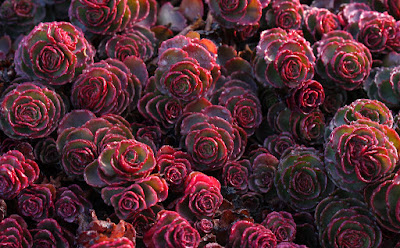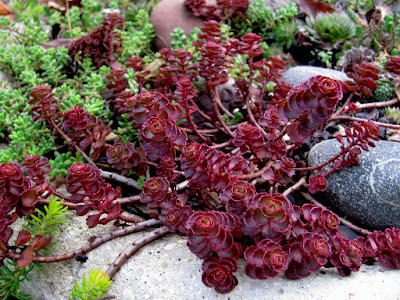Dragon's blood Sedum also called as Sedum spurium ‘Schorbuser Blut’, Phedimus spurius ‘Dragon’s Blood’, has all the features of other green roof spuriums - exceptional drought tolerance, hardiness in heat and cold, dense foliage, vivid flowers, and winter rosettes.
Dragon's blood Sedum also called as Sedum spurium ‘Schorbuser Blut’, Phedimus spurius ‘Dragon’s Blood’, is a cultivars of Sedum spurium. Any of the red spuriums can be called by the common name ‘Dragon’s Blood’, but this name encompasses several distinct cultivars. Developed in Germany under the cultivar name of 'Schorbuser Blut', but sold in commerce in the U. S. under the trade name of Dragon's blood, this plant looks great in all seasons. It has all the features of other green roof spuriums - exceptional drought tolerance, hardiness in heat and cold, dense foliage, vivid flowers, and winter rosettes.
IDENTIFY DRAGON'S BLOOD SEDUM
Dragon's blood Sedum is a mat-forming evergreen perennial, which reaching to 10 cm in height, that rapidly forms a carpet of glossy jade and red succulent leaves. The brilliant colours are intensified with direct sunlight. The leaves turn greener towards the stem in summer, but retain their bright red margins.
Small dark pink flowers which rise to 6-inches create a bright layer of color over the lush carpet of foliage in mid to late summer, and dark red rosettes appear throughout winter. It is a fine selection for spotting into rock walls and is also a great choice for modern style compositions in spare geometric containers or grouped with other graphic succulents. It is perfect for troughs and alpine gardens.
DRAGON'S BLOOD SEDUM CARE AND CULTURE
Cultural information should only be used as a guide, and should be to be adapted to suit you. Your physical location; where you grow your plants, how much time you have to devote to their care, and many other factors, will need to be taken into account. Only then can you decide on the cultural methods that best suit you and your plants.
Light:
Dragon's blood Sedum grows best in bright light to full sun but also grows in light shade or partial shade. This versatility makes them great for outdoor gardens. You can plant them in the sunniest part of your garden or keep them in a planter on a covered patio. They’ll do great in either location!
Temperature:
Sedum spurium ‘Schorbuser Blut’ grows well in zones 4 to 9 and do best outdoors. The plants are evergreen in warm winter climates. It should be brought indoors during the winter once the temperature drops below 65 °F . Plant back outdoors when the temperature rises to at least 60 °F.
Substrate and growing media:
Dragon's blood Sedum is a type of creeping succulent that spreads out and makes great ground cover. When growing in containers, they grow low and hang over the sides of the containers, so they provide a nice contrast in arrangements with lots of tall plants. Try planting this succulent in pallet gardens, hanging baskets, planting beds, or rock gardens. They’re perfect for any bare spots in your garden, too, because they’ll fill them in quickly.
When growing in pots, you need to choose container that will be 70-150% bigger than the roots ball, choose container shallow 10-15 deep will be enough possible bit more deep that but no point, the pot need to be shallow and wide, size of container can be minimum 5-8L but bigger better and in order to keep the plant in small need to cut the roots that will be place to re-grow again, drainage of the soil it’s important, but after few years drainage of the soil not function the same so need to change it to new soil, and in order to have good drainage possible to use potting mix, cactus potting mix or sandy soil better to put little stone little rocks like: gravel, lava rocks or pebbles.
It is extremely urban tolerant, and is usually reserved for highly stressful sites around rockery that exposes it to thin soils, poor soils, very dry soils, soils of various pH, low fertility, extreme heat, drought, full sun, and high light reflectance; however, it is not tolerant of wet or poorly drained soils.
Watering:
Dragon's blood Sedum has thick, fleshy leaves that store water. Those water-hoarding leaves help make the plant drought-tolerant. It is sensitive to overwatering which is why you should wait until the soil has dried out in between watering before you water again. Overwatering may result in fungal diseases. These plants are also drought tolerant, so they bear well if you neglect them for a while.
Never let your plants sit in water. Do not water on the leaves. If you water from beneath by letting the plant sit in a saucer of water, make sure to pour off any excess water after a few minutes. The hotter it is outside, the faster your soil will dry out, so you’ll need to water more often if you live in a hot area. Water with caution in winter, as the plant can lose its roots if the soil stays cold and wet for extended periods; protect from frost to prevent scarring.
Fertilizer:
The plant can be fertilized with balanced, low number fertilizer to help with poor soil and you can even help it out with deadheading the dried flowers. Apply 2 tbsp. of an all-purpose slow release fertilizer upon the ground in a band around the plant at least 6” away from its stems. Don’t fertilize after mid September.
Pruning:
Pruning in the winter isn't necessary, but the plant can be pinched back in late winter to promote compact growth or control its size. The leaves can be pinched back to the lowest lateral branch. Any remaining flowers can also be removed at this time
Propagation:
Dragon's blood Sedum are propagated primarily by rooted stem cuttings, but also by crown division or segmentation of the self-rooted prostrate stems. Cutting can be from leaves or stems, cut in the base of the leaf will be better, possible to cut stems or in middle of the leaf, need to let the few days in location with shade and let it heal and dry little bit before put it in the soil, after this put the leaves of stems in the soil watering it with moist and don’t overwater also easier method it’s to bending a branch over and covering it with soil. This plants can also be grown from seeds.

















COMMENTS